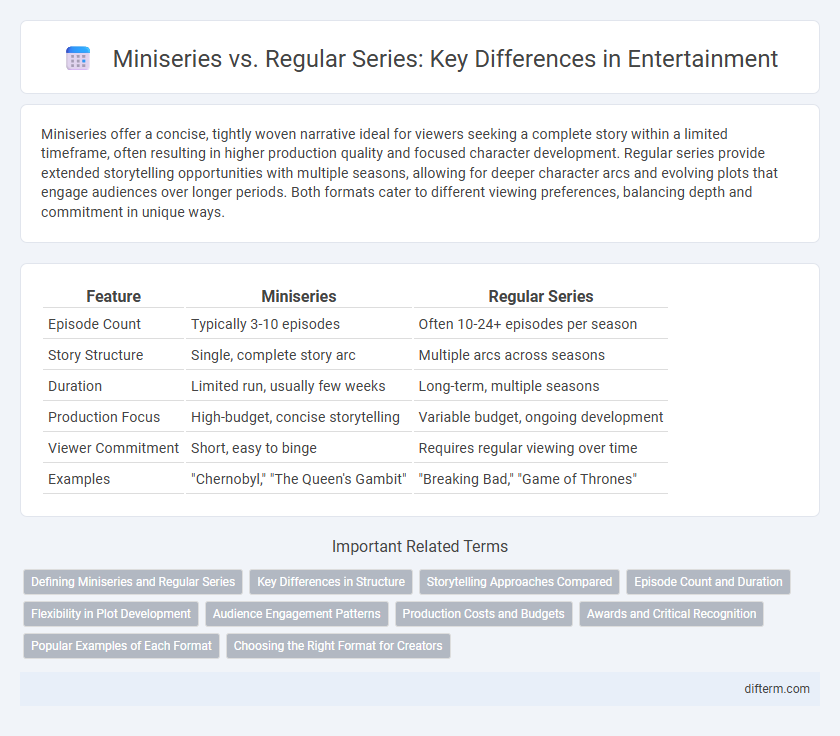Miniseries offer a concise, tightly woven narrative ideal for viewers seeking a complete story within a limited timeframe, often resulting in higher production quality and focused character development. Regular series provide extended storytelling opportunities with multiple seasons, allowing for deeper character arcs and evolving plots that engage audiences over longer periods. Both formats cater to different viewing preferences, balancing depth and commitment in unique ways.
Table of Comparison
| Feature | Miniseries | Regular Series |
|---|---|---|
| Episode Count | Typically 3-10 episodes | Often 10-24+ episodes per season |
| Story Structure | Single, complete story arc | Multiple arcs across seasons |
| Duration | Limited run, usually few weeks | Long-term, multiple seasons |
| Production Focus | High-budget, concise storytelling | Variable budget, ongoing development |
| Viewer Commitment | Short, easy to binge | Requires regular viewing over time |
| Examples | "Chernobyl," "The Queen's Gambit" | "Breaking Bad," "Game of Thrones" |
Defining Miniseries and Regular Series
Miniseries are limited-run television programs with a predetermined number of episodes designed to tell a complete story arc, typically ranging from 2 to 10 episodes. Regular series, also known as episodic series, consist of multiple seasons with ongoing storylines or episodic content, allowing for character development and plot expansion over extended periods. The defining distinction lies in miniseries' concise narrative scope versus regular series' potential for continuous storytelling and character evolution.
Key Differences in Structure
Miniseries typically feature a predetermined, limited number of episodes, usually ranging from 3 to 10, designed to tell a concise, complete story without extending beyond its narrative arc. Regular series often have multiple seasons with episodic or serialized plots that can evolve over time, allowing for character development and story expansion. The structure of miniseries emphasizes a tight, focused storytelling experience, while regular series prioritize ongoing viewer engagement and long-term plot progression.
Storytelling Approaches Compared
Miniseries typically offer a concise, tightly woven narrative arc with a predetermined endpoint, allowing for focused character development and a clear resolution. Regular series often employ episodic storytelling with ongoing subplots that evolve over multiple seasons, providing flexibility for deeper world-building and character exploration. This structural difference impacts pacing and viewer engagement, with miniseries delivering a more intense, immersive experience in a shorter timeframe.
Episode Count and Duration
Miniseries typically consist of a limited number of episodes, ranging from 3 to 10, with each episode lasting 45 to 90 minutes, offering a concise and focused narrative arc. Regular series often feature 10 to 24 episodes per season, with episodes averaging 20 to 60 minutes, allowing for extended character development and multiple storylines. The shorter format of miniseries appeals to viewers seeking a complete story in a limited time, while regular series cater to audiences desiring ongoing entertainment and deeper plot exploration.
Flexibility in Plot Development
Miniseries offer concentrated storytelling with a fixed number of episodes, allowing for a tightly woven plot and intentional pacing without the need for filler content. Regular series provide ongoing flexibility in plot development, enabling character arcs and storylines to evolve over multiple seasons based on audience feedback and ratings. This adaptability allows regular series to explore complex narratives and introduce new subplots, whereas miniseries maintain a focused and cohesive narrative structure.
Audience Engagement Patterns
Miniseries generate intense audience engagement by delivering a concise, tightly woven narrative that sustains viewer interest over a limited number of episodes. Regular series build long-term engagement through evolving story arcs and character development, encouraging consistent weekly or seasonal viewership. Audience retention in miniseries often peaks early, while regular series rely on gradual emotional investment and cliffhangers to maintain viewership momentum.
Production Costs and Budgets
Miniseries typically have higher production costs per episode compared to regular series due to their condensed storytelling, which demands higher-quality sets, cast, and special effects within a limited episode count. Regular series often allocate budgets over multiple seasons, allowing for more flexible spending and gradual character development, resulting in lower per-episode costs. Budget allocation in miniseries emphasizes cinematic quality and tight scripts, whereas regular series balance production value with long-term audience retention strategies.
Awards and Critical Recognition
Miniseries often receive concentrated critical acclaim due to their tightly woven narratives and limited episode count, garnering prestigious awards such as Emmys in categories like Outstanding Limited Series. Regular series, with their extended seasons, accumulate recognition over time, frequently earning nominations and wins across a broader range of categories including acting, directing, and technical achievements. The focused storytelling of miniseries tends to attract intense critical recognition per season, whereas regular series build sustained acclaim through character development and long-term viewer engagement.
Popular Examples of Each Format
Miniseries like "Chernobyl" and "The Queen's Gambit" captivate audiences with their concise, high-impact storytelling across limited episodes, offering a complete narrative experience. Regular series such as "Stranger Things" and "Game of Thrones" attract viewers with ongoing character development and complex plotlines spanning multiple seasons. Both formats have distinct fan bases driven by the depth of content and binge-watching appeal.
Choosing the Right Format for Creators
Miniseries offer creators a concise storytelling format with a predetermined number of episodes, allowing for tight narrative control and a definitive conclusion. Regular series provide ongoing opportunities for character development and audience engagement through multiple seasons, enabling creators to explore complex story arcs over time. Choosing the right format depends on the story's scope, budget constraints, and the creator's vision for narrative depth and audience retention.
miniseries vs regular series Infographic

 difterm.com
difterm.com